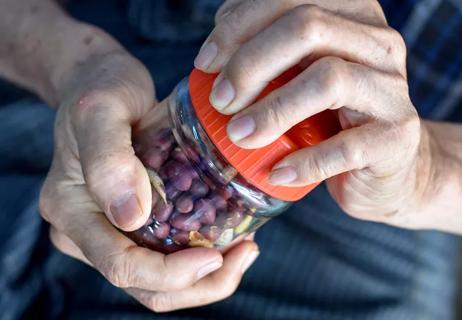Getting close to their care team, investing in accessibility and implementing safe sleeping practices are just a few ways to support your child’s growth and development

Nothing can really prepare you to have a baby. It’s even harder to feel ready when you find out your baby has a disabling genetic condition like spinal muscular atrophy (SMA). Caring for them means a massive lifestyle adjustment. But the more you understand SMA and the challenges it poses, the better support you can provide from day one.
Advertisement
Cleveland Clinic is a non-profit academic medical center. Advertising on our site helps support our mission. We do not endorse non-Cleveland Clinic products or services. Policy
Pediatric neurologist Alexandra Bonner, MD, shares the different ways you and your baby’s care team will promote their growth and development.
In order to understand your role as an SMA caregiver, it’s important to know the common health hurdles babies with this chronic illness encounter as they make their way into toddlerdom.
The type of SMA your baby has will determine a lot about both the severity of their challenges and their long-term outlook. So do the types of treatments they receive and when.
Whatever their exact diagnosis may be, there’s a lot of reason to be hopeful. SMA treatments — most of which didn’t exist 10 or even five years ago — are prolonging children’s lives and ability to function.
But with any revolutionary treatment comes uncertainty.
“It’s really challenging to know exactly what long-term outcomes are going to look like,” Dr. Bonner says. “We hope that these therapies will allow your child’s clinical course to stabilize over time, but it’s too soon to know for sure if (and how) that will happen. In the meantime, we still need to support them as they grow and develop.”
Dr. Bonner shares some of the challenges children with SMA typically face — and the adjustments you and your baby’s support team will make to address them.
Advertisement
Your baby’s breathing and swallowing will be assessed as soon as they’re born. For some babies and toddlers living with SMA, these issues require long-term management.
“SMA is a disorder that affects the function of muscles. We use the muscles in our throats to swallow food. And we use the muscles in our chest and thorax to breathe,” Dr. Bonner explains.
Your kiddo’s care team will determine whether your baby is able to feed and swallow enough to gain weight and maintain their growth curve. If the answer is “no,” they may need to provide extra nutritional support.
It’s the same story for breathing. Like all babies, yours will be closely monitored to ensure they’re breathing comfortably enough to go home from the hospital. If they need respiratory support in the NICU (neonatal intensive care unit), pulmonary specialists will work quickly to decide how best to assist them.
What and how your baby eats depends on the kind of SMA they have and how it affects their digestion. There’s no one-size-fits-all plan. But here are a few common complications your provider will keep in mind as they craft a nutrition plan for your little one.
When your baby has SMA, their motor neurons don’t communicate with their muscles, leading them to atrophy over time. That’s a problem because your muscles provide critical support to your skeletal system, including your joints and spine. Without that support, issues like scoliosis can develop.
“The core members of your child’s care team will monitor them for symptoms of musculoskeletal complications,” Dr. Bonner says. “But there’s usually a low threshold for bringing in physical medicine, rehabilitation and orthopaedics specialists. It’s important to intervene early to prevent long-term problems.”
There are three main types of physical therapists your child may work with to ensure they’re as strong and independent as they can possibly be:
Advertisement
Assistive technologies will be an essential part of your child’s SMA care plan. Some of those items will fall into the category of medical devices. These devices will address the SMA complications we’ve discussed here and more. Examples include:
Your child will also likely benefit from different kinds of adaptive equipment. These tools will allow them to participate in activities or complete daily tasks as they grow up. Here are some examples:
Everybody modifies their home in preparation for a new baby. But if your baby has SMA, the changes being made tend to go beyond standard babyproofing. You’ll work with your child’s occupational therapist to decide what changes will be most helpful for your little one as they grow up. Common modifications include:
You’ve probably heard the saying “It takes a village to raise a child.” As you embark on this SMA caregiving journey, you’re going to need a village as much as your child does. And that village is bigger than just your care team.
Advertisement
You’ll need the help and comfort of your friends and loved ones. You’ll need mental health support. And you’ll need to tap into the community that other SMA and neuromuscular disorder caregivers have built. Organizations like Cure SMA and the Muscular Dystrophy Association offer a wealth of information, experience and empathy that you can draw on as you adapt your life to help your baby thrive.
Together, you and your village will do what it takes to give your child a wonderful life.
Advertisement
Learn more about our editorial process.
Advertisement

Whether it’s crushed ice, a chilled gel pack or frozen corn, you’ve got options

These neurological conditions affect muscle movement in separate ways

Your child’s care team, nonprofit organizations, patient groups and more are here to support you

This treatment can be an effective way to calm muscle stiffness and spasms from nerve damage

Stretching, water-based activities, cycling and treadmill training can all bring benefits

Stretching, heating pads and massage guns can provide quick relief

Turns out your health really is in your hands

Seven doctor-approved ways to ease the pain

Babies can get congested easily, but you can calm their cough by keeping them hydrated, using nasal drops and running a humidifier

Weight loss may cause loose, sagging skin and muscle loss to your rear

Several conditions, like vitiligo and fungal infection, can cause a loss of pigmentation, leading to white spots or patches on your skin